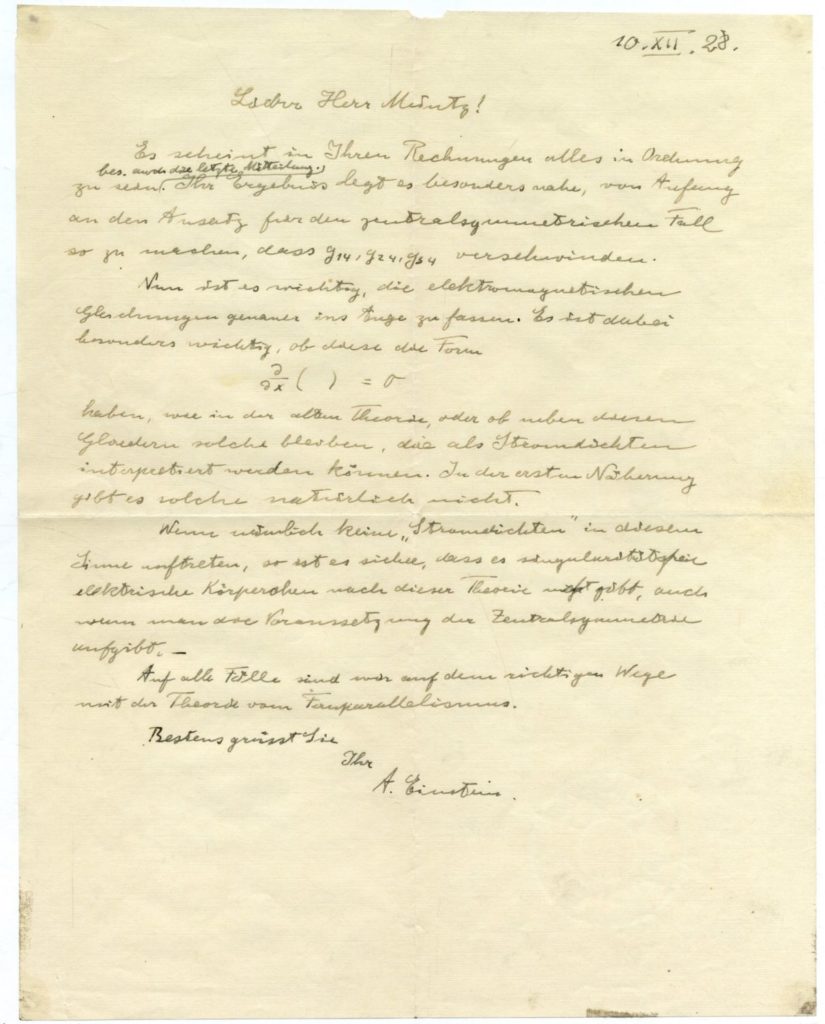
Letter written and signed by Prof. Albert Einstein regarding the “Unified Field Theory of Gravitational Force and Electromagnetism” to his colleague, mathematician Prof. Herman Muntz. With a scientific comment that Einstein jotted down on the original envelope. 10.12.1928.
Specifications: [1] ink on paper. Signed autograph. 27.5×22 cm. German. [25] lines written in ink by Einstein. In addition, [1] envelope addressed by Einstein to Dr. Herman Muntz. 12.5×15 cm. Einstein added [3] lines in his hand to the envelope. The envelope bears a stamp with the word “Berlin.”
Unique features: This letter is a unique, significant historic document that reveals Einstein’s thought process and his methods at that point in time, regarding his Theory of Relativity, one of the most significant scientific achievements of the 20th century. It was written during one of the most exciting, feverish periods of Einstein’s scientific career. About a month after writing this letter, he published his article regarding the Unified Field Theory [UFT], in which he discloses the final stages of the development of this theory, and it reveals critical stages in the solution that he presents. This theory tried to achieve one unified formula that would unite the electromagnetic and gravitational fields and present them as different manifestations of a single universal force. In this letter, Einstein reaches conclusions that will later stand at the base of his theory regarding the mathematical format of the electromagnetic equations. Einstein gives a more specific formulation after he already finished the letter, on its envelope! The new approach to the theory that Einstein wrote in the three lines on the envelope, a short time after writing and sealing the letter, discloses Einstein’s genius creative mind. It also reveals the feverish pace, within a few hours – or at most a day – during which Einstein could sharpen his basic approach to a very complicated problem, while making a very quick turn about. Einstein’s letter and his statements during this period indicate that he considered the Unified Field Theory a central part of the Theory of Relativity and viewed it as the third stage in its development, following the Special Theory of Relativity and the General Theory of Relativity. During the last forty years of his life, Einstein was obsessed with the “unitary tendency” and his search for the field equation for the total field. This letter discloses an aspect of this obsession, in a moment of perhaps Einstein’s most important period of his unification program. On the very same day that he wrote this letter, Einstein submitted a paper to the editor of the “Festschrift,” so it can be used to shed light on Einstein’s philosophical drive and mood at the time. He states that phenomena according to the UFT theory would take on such a structure “that even G-d Himself could not have arranged those connections in any other way than that which factually exists, any more that it would be in His power to make the number 4 into a prime number .” In his book Thematic Origins of Scientific Thought, Kepler to Einstein (1973), Mr. Gerald Holton points to the philosophical kinship of Einstein’s position with that of Johannes Kepler in his Mysterium Cosmographicum where he announced that he wanted to discover the number, positions and motions of the planets, “why they are as they are, and not otherwise,” and who wrote to Herwart in April 1559, that with regard to numbers and quantity, “Our knowledge is the same kind as G-d’s, at least insofar as we can understand something of it in this mortal life.”
Background: To demonstrate the significance of this letter, we must note Einstein’s article of 3.2.1929, in which he presents his new discoveries. There he states that his Theory of Relativity reached its third stage over the last six months. In 1928, Einstein suffered a temporary physical collapse due to an enlarged heart and he had to stay in bed for four months. He fully recuperated but remained weakened for a year. At the end of May 1928, he wrote to his friend Zagger: “In the tranquility of my sickness I have laid a wonderful egg in the area of general relativity. Whether the bird that will hatch from it will be vital and long-lived only G-d knows.” The “egg” that hatched was Einstein’s important paper on UFT, and it was the result of six months of hard work. In addition, in an interview with the “Daily Chronicle” on January 26th, Einstein stated: “Now, but only now, we know that the force which moves electrons in their ellipses about the nuclei of atoms is the same force which moves our earth in its annual course about the sun, and it is the same force which brings us the rays of light and heat which make life possible upon our planet.”
Prof. Herman Muntz [1884-1956] was a Jewish-German mathematician who was Einstein’s colleague in 1927-1929. He helped Einstein with the complex mathematical equations related to the physical theories he developed.
Condition: Very fine. Fold marks. Tear on the side of the envelope, not affecting text. This lot includes a certificate of authenticity.
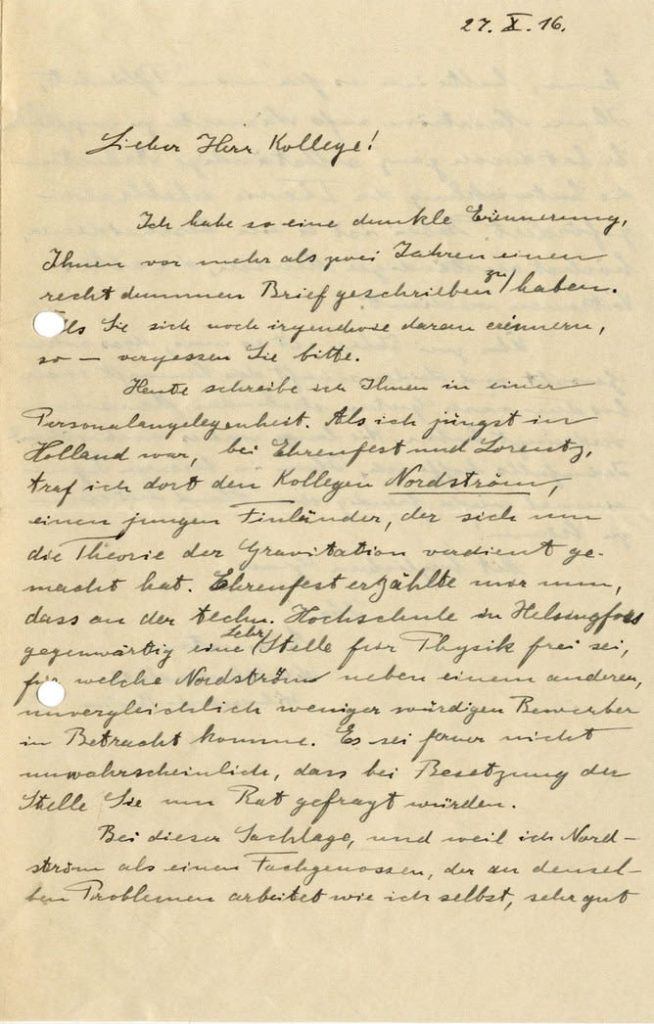
Correspondence between Prof. Albert Einstein and his colleague Danish Prof. Martin Knudsen.
Specifications: [2] pages. Ink on paper. 22×14 cm. 43 lines written and signed by Einstein. Written on the 27th of October, 1916. A printed answer from Martin Knudsen to Einstein, dated the 4th of November, 1916 is attached.
Content: In this important letter, Einstein writes to Martin Hans Christian Knudsen [1871-1949], professor of physics at the Copenhagen University. He recommends his colleague, Finnish scientist Gunnar Nordstrom, for tenure at the University of Helsinki. The letter was sent at the end of 1916, shortly before Einstein published his General Theory of Relativity. Einstein notes that he had recently met Nordstrom in Holland. Nordstrom was a Finnish physicist who studied the Theory of Gravitation and was a colleague of Hendrik Lorentz and Paul Ehrenfest. Einstein was impressed by Nordstrom, both as a physicist and human being. At the end of the letter, Einstein mentions the First World War, which had already been raging for two years. In line with his pacifist views, he complains about the violence and lack of reason, and wonders how long the war will continue.
Background: Martin Knudsen [1871-1949] was a Danish physicist, a lecturer and researcher at the Technical University of Denmark. He is primarily known for his studies of molecular gas flow and the development of the Knudsen cell which measures the vapor pressure of materials amid temperature control of the evaporation process.
Gunnar Nordstrom [1881-1923] was a theoretical physicist noted for his theory of gravitation, which competed with Einstein’s General Theory of Relativity for a number of years. This competition caused his colleagues to call him “The Einstein of Finland.”
Condition: Very fine, other than filing holes affecting isolated letters.
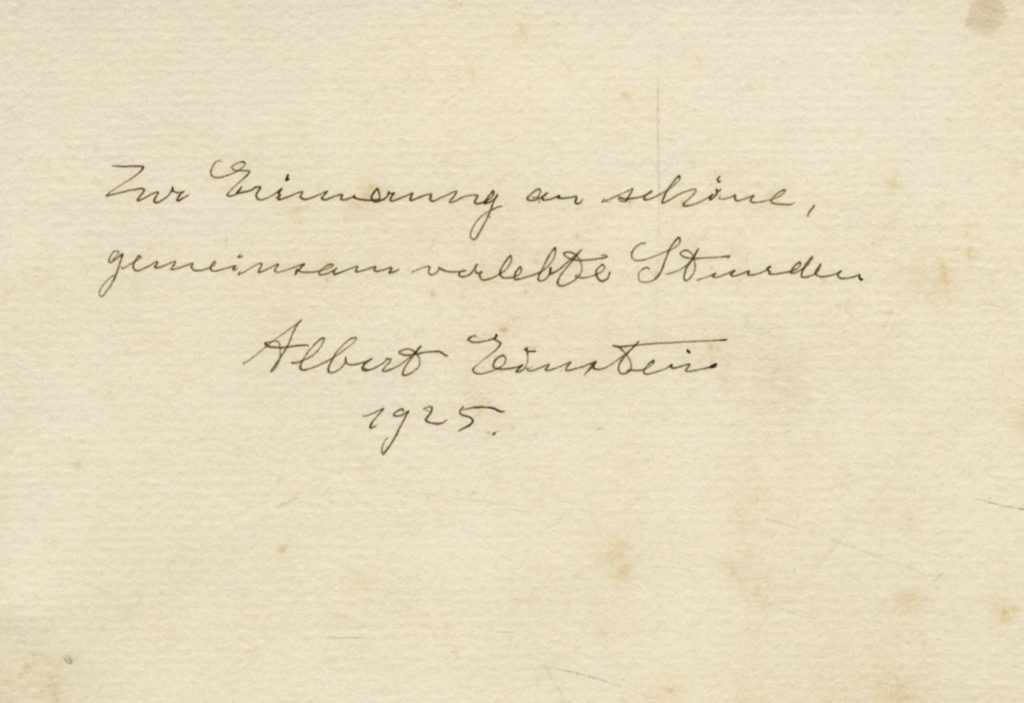
Magnificent invitation, with a festive gastronomic menu, to an event with Prof. Albert Einstein as the guest of honor in the University of the Republic of Uruguay in Montevideo. Park Hotel, 30.04.1925. The invitation was inscribed and autographed by Prof. Einstein to the Foreign Minister of Uruguay, Dr. Juan Carlos Blanco Acevedo.
Specifications: [1] double leaf, within a printed jacket binding made of cardboard and tied with a lace. 18×12 cm.
Background: Prof. Einstein’s trip to Uruguay in 1925 and his appreciation for its beauty and the quality of its people has become one of the Uruguayan myths that is related with much pride. On 24.04.1925, Einstein arrived from Argentina for a week-long visit in Montevideo, Uruguay. During his trip, Einstein delivered a series of scientific lectures. He was impressed by the country’s natural scenery and its buildings, its citizens and its special character, and he noted his experiences in his personal journal. The journal describes Uruguay as a small and happy country with exquisite natural scenery, beautiful weather, hot and damp, and amazing architecture. He was also impressed with the liberality of the country, its socialist laws and its constitution, which was somewhat similar to that of Switzerland.
His visit concluded with a magnificent event in his honor at the Park Hotel, arranged by the Uruguayan government and the local university. At the event, he sat next to the president of the Republic Eng. Jose Serrato and the Foreign Minister, enjoying warm conversation with them. Einstein wrote a personal inscription to the foreign minister on the gourmet menu prepared for the event. Freely translated, he wrote: “Souvenir of the wonderful hours we were together.”
Years later, this Foreign Minister headed the Uruguayan delegation to the United Nations that voted for the establishment of the State of Israel on 29.11.1947. On 25.03.2006, this menu was displayed in the halls of the LATU (Laboratorio Tecnológico del Uruguay) in Montevideo, at a prominent international exhibition.
Condition: Fine-very fine. Minimal aging stains. Traces of tape on the back.
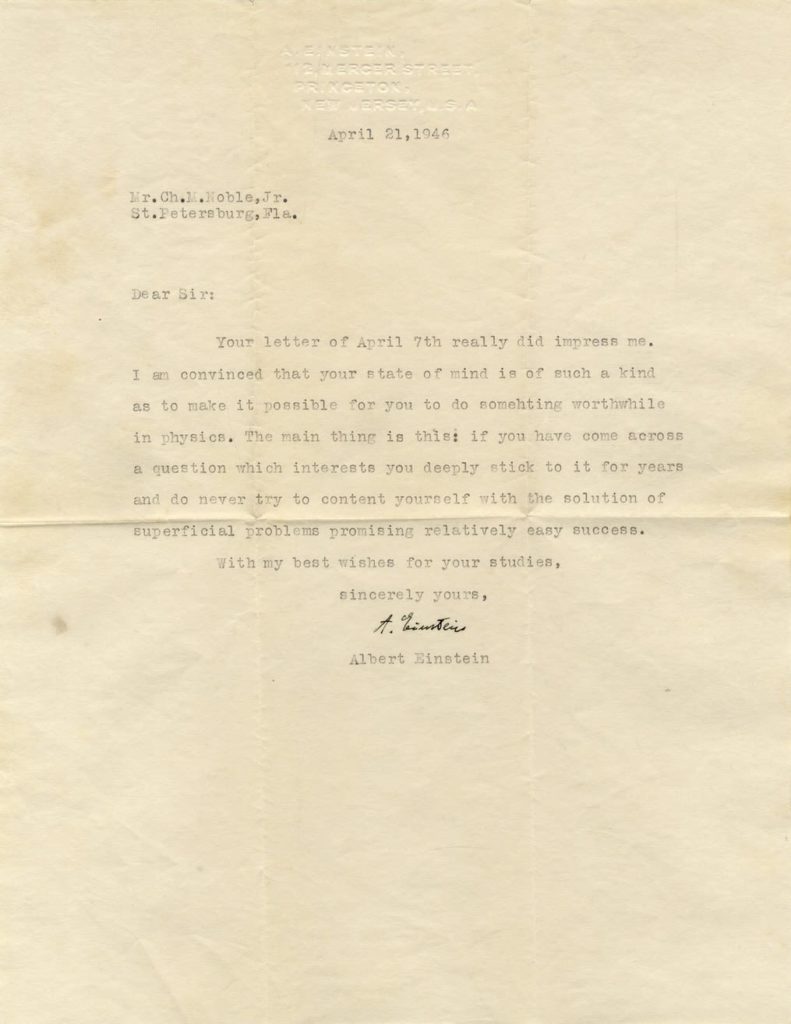
Letter indicating Einstein’s uncompromising approach in his search for solutions to complicated problems. This letter was sent to Mr. Noble, a chemist who had just finished serving as a navigator during the Second World War and was unsure what step to take on his professional path. Princeton, 1946.
Specifications: [1] letterhead, typewritten, signed by Prof. Einstein. 28×21 cm. English. Includes [1] original envelope, 9×16 cm. Postmarked 21.4.1946.
Subject: Einstein tells Noble that he was impressed with his letter and is convinced that he has the capabilities for significant achievements in physics. “The main thing is this: if you have come across a question which interests you deeply stick to it for years and do never try to content yourself with the solution of superficial problems promising relatively easy success.”
Mr. Clymer Marlay Noble Jr. finished his studies in chemistry at UC Berkeley and served as a navigator in the U. S. Air Force during the Second World War. His deliberations regarding his next career step caused him to write Einstein and ask for his advice. This letter is an integral part of Einstein’s legacy. It portrays a caring person interested in giving advice and guidance that is relevant to everybody unsure and uncertain of their path, and not just this specific addressee. Mr. Noble decided to pursue chemistry and he worked in the field for thirty years.
Condition: The letter is in excellent condition, other than fold marks. The envelope has light tears on its side.
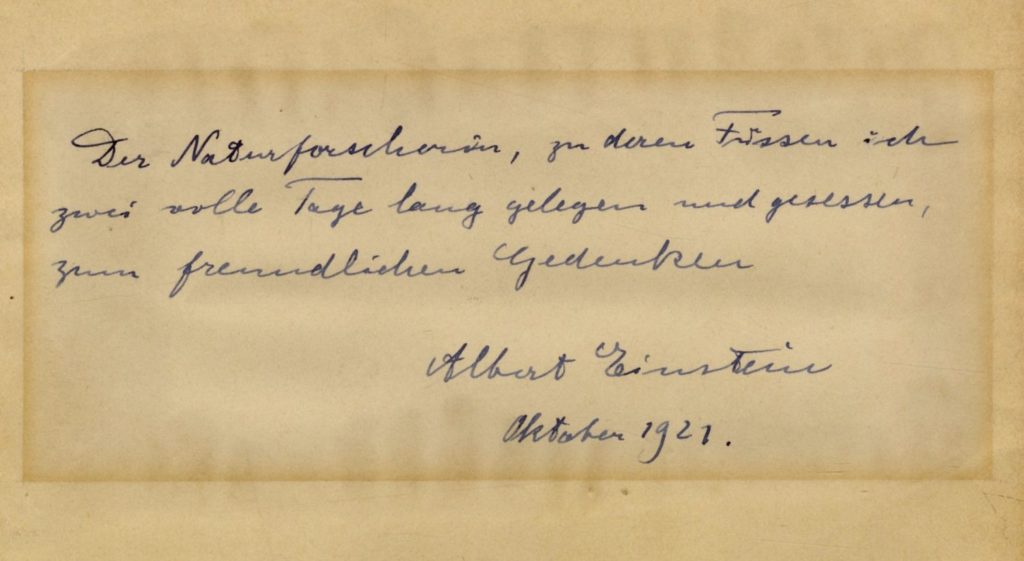
“To the scientific researcher, at whose feet I slept and sat for two full days, as a friendly souvenir. Albert Einstein, 1921.”
Background: In October 1921, Albert Einstein visited his sister, Maja, for a few days in Florence, Italy. He was already a prominent scientist at the time, worthy of receiving the Nobel Prize the following year. During his visit, he learned that one flight up from his sister’s apartment lived a young chemistry student, Elisabetta Piccini [March 19, 1899- June 18, 1990].
Elisabetta, daughter of famed Italian chemist, Augusto Firenze [1854-1905], was a researcher of physical chemistry at the University of Florence together with Prof. Luigi Mazza [1898-1978]. The next year they published a joint article in the framework of Italian national academics regarding the conductivity of nitrous sulfur.
It’s very possible that the name of this young talented researcher was known within the physical chemistry community of researchers and Albert Einstein was very interested in meeting her. However, Elisabetta was introverted and too shy to meet with such a famous person. She refused to meet him.
When Einstein left Florence to participate in a scientific conference in Bologna, he left this note for Elisabetta:
” Der Naturforscherin, zu deren Fuessen ich zwei volle Tage lang gelegen und gesessen, zum freundlichen Gedenke” (To the scientific researcher, at whose feet I slept and sat for two full days, as a friendly souvenir).
Specifications: [1] leaf. 9×15 cm. German. Five lines in Einstein’s hand and with his signature. The note is pasted to another slightly-bigger piece of paper with a poem by Elena DeAngelis – Elisabetta’s good friend.
Was Einstein interested in a romantic relationship with Elisabetta? Was he hinting at this in his note?
Condition: Very fine.
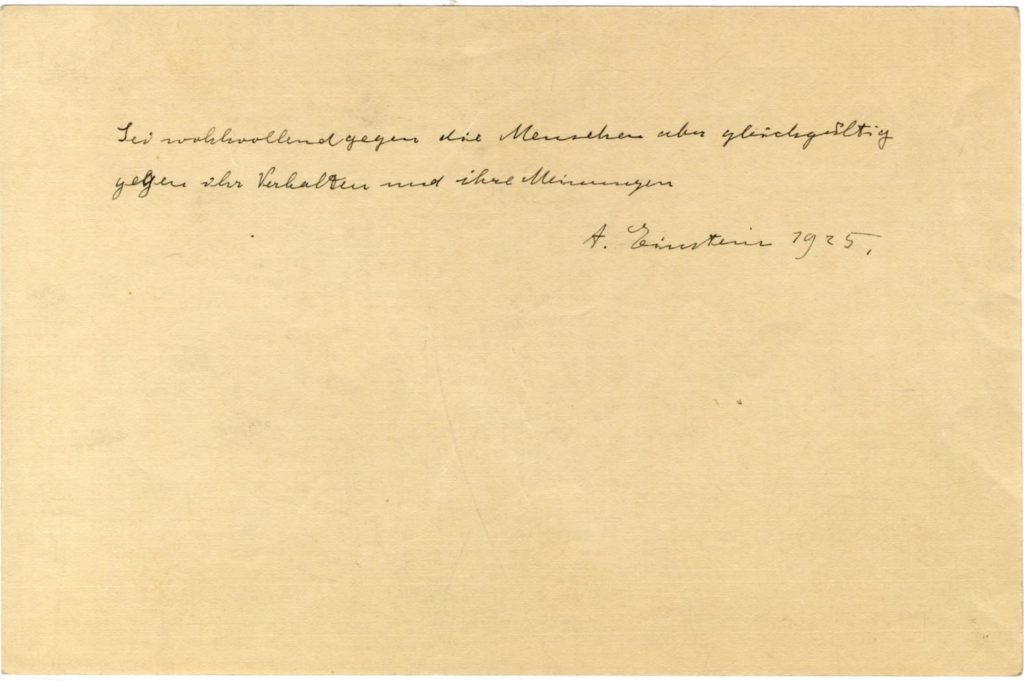
Piece of paper on which Einstein expressed his approach to society. 1925.
Specifications: [1] paper. 12.5×19 cm. German. Three lines in his hand and with his signature.
Content: Free translation from the original German:
“Be pleasant to people, but indifferent to their behavior and opinions. A. Einstein 1925.”
In this approach, Einstein expresses the secret of his relationship with society. One one hand, he displayed social sensitivities and was very warm to the people around him; but, at the same time, he guarded his independent manner of thinking and did not submit his thoughts or behaviors to social norms. It is possible that it was this approach that allowed him to develop his unique talents and his groundbreaking novel insights, while remaining a pleasant man of society. His indifference to the behavior of the people around him along with the preservation of his unique style led to the scientist’s unique behaviors that were at times strange or humorous.
Condition: Very fine.
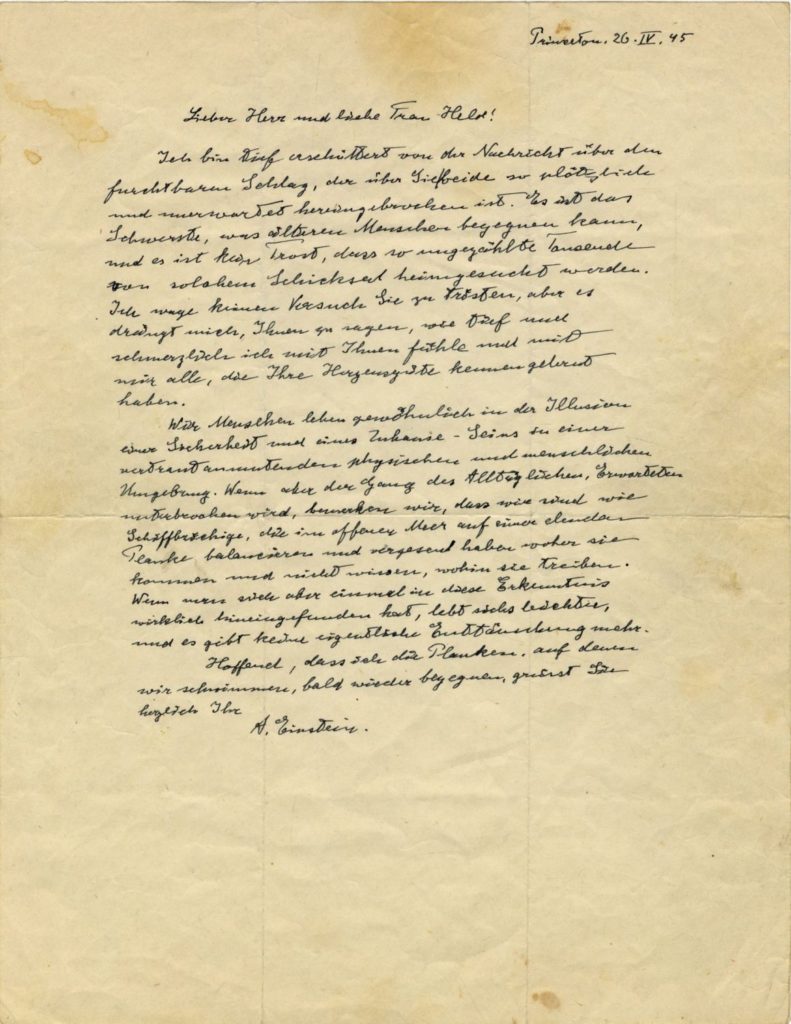
“We are like seafarers whose boat has sunk …” Exceptionally sensitive and honest condolence letter from Prof. Albert Einstein to Mr. and Mrs. Held. Princeton, 26.04.1945.
Specifications: [1] ink on paper. 27.5×21.5 cm. German. 28 lines written and signed by Einstein.
Background: This letter discloses Einstein’s sensitive approach as he tries to console the Helds in the face of a family tragedy, the loss of family members during the Second World War. The letter was written towards the end of the war, and the tragedy possibly relates to Holocaust or battle victims. Einstein notes in his letter, that he does not see it as a consolation that a massive amount of other people are struggling with their own personal tragedies; he feels the need to express how deeply he emphasizes with them. Einstein compares experiencing a tragedy that abruptly cuts off one’s path in life and destroys illusions of personal safety to a ship that sank at sea, with its survivors grasping desperately to planks of wood as they battle to preserve their balance and drift to an unknown destination. He finds a point of consolation in the fact that even those people living on a dismal plank eventually reach some kind of peace with their situation and suffer less from their condition. He continues along with the comparison – of their and his lifesaving plank- as he expresses his hope to meet with them soon. His expression indicates that Einstein identified with their pain and also found himself floating on a plank at sea. It is very possible that Einstein also felt as if he was “floating at sea” in 1933, when Nazi Germany invalidated his citizenship and plundered his assets and he was forced to escape and build a new life as a refugee in a foreign country.
Freely translated, the letter reads as follows:
Dear Mr. and Mrs. Held, We humans generally live with an illusion of security and a feeling of domestication, in a familiar physical and human surrounding. However, when our daily predictable life is cut off, we find that we are like sea travelers whose ship has sunk and are forced to try to maintain their balance on a miserable plank of wood. People forget their point of departure and don’t know to where they’re drifting. When they reach this realization, they make peace with the situation, and life becomes easier, and there is no more room for real disappointment. Hoping that the planks on which we sit will soon meet, I send my deep-felt regards, yours truly, A. Einstein.
Condition: Fine-very fine. Fold marks, minimal aging stains.
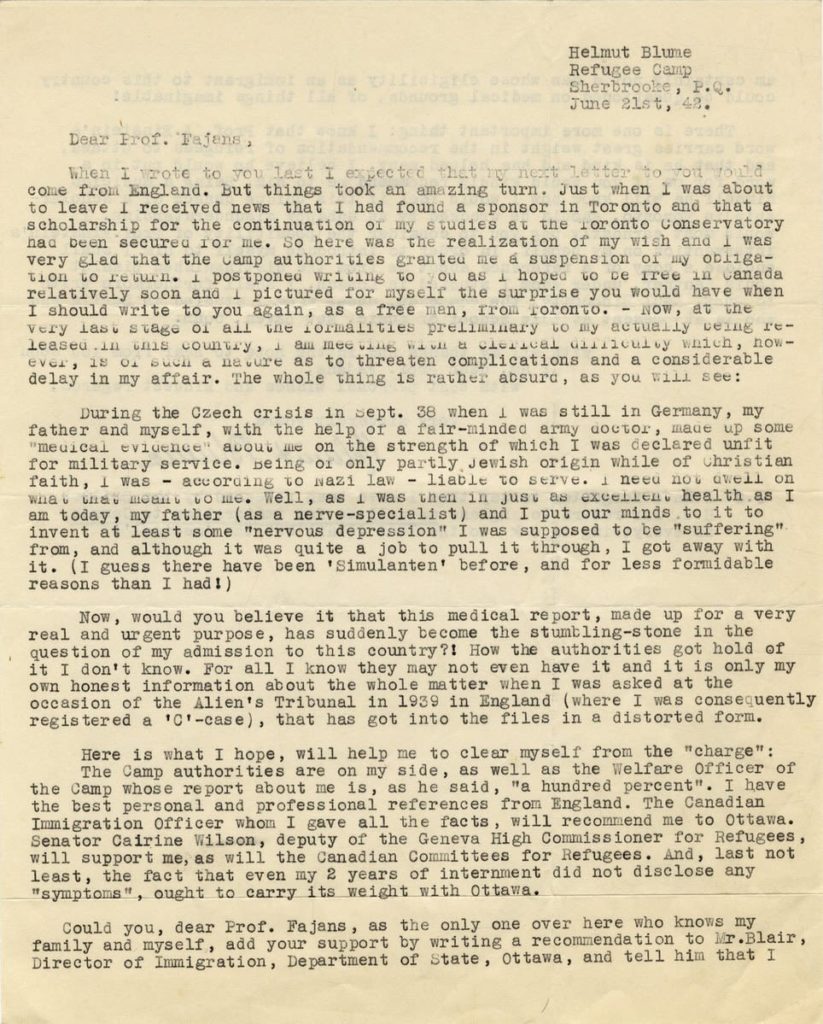
Collection of [10] letters, including [4] letters from Prof. Einstein, relating to his efforts to release a young musician from a refugee camp in Canada. Summer 1942.
Helmut Blume evaded the draft to the Nazi army by pretending to be feeble-minded. Later, this classification prevented him from being admitted into Canada, and he was held in a refugee camp in the country. In a letter to his relative, Prof. Fajans, Blume asked him to write a letter on his behalf to Mr. Blair, the director of the Canadian government’s immigration department in Ottawa. Blume also asked Prof. Fajans to ask his colleague, Prof. Albert Einstein, to write a similar letter. Fajans wrote a letter to Blair asking for Blume’s release from the refugee camp, noting his personal impression that Blume did not suffer from emotional problems and suggested that he be released. He expressed his confidence that Blume’s release would be a blessing for the community in which he would settle. Fajans also sent a copy of Blume’s letter to Einstein and asked him to act on Blume’s behalf. As soon as Einstein received Fajans’ letter, he wrote his own letter to Blair. He explained that the circumstance behind Blume’s diagnosis as depressive was only a means to be released from the German army, and he supports his release. He emphasized Blume’s musical abilities, his political loyalty, and the fact that he was a distant cousin of his colleague, Prof. Fajans. Einstein sent Fajans a copy of the letter that he sent to Blair. Einstein did not receive a response from the Canadian immigration authority, so he sent them another letter on behalf of Blume. Again, he updated Fajans about this second letter. In the meantime, Blume was informed that he won a scholarship to study at the Toronto Conservatory of Music. Prof. Fajans reported the efforts made to release him, and Blume wrote thank-you letters to Fajans and Einstein. Shortly following their efforts, the Canadian immigration authority decided to release Blume and allow him to make use of the scholarship and study in the Toronto Conservatory of Music, as indicated by Blair’s letter to Fajans. Einstein was happy to hear the positive developments regarding Blume’s release from the refugee camp, and expressed his satisfaction in a letter to Prof. Fajans.
Background: Prof. Kazimierz Fajans [1887-1995] was a Jewish, Polish-American physicist-chemist, a pioneer in the study of radioactivity and the discoverer of protactinium. He studied chemistry in Germany and finished his doctorate in 1909. He headed the faculty of physical chemistry in Munich. In 1935, he left Germany and moved to Cambridge. He later moved to the United States where he joined the faculty of the University of Michigan. Helmut Blume [1914-1998] was a talented, Jewish-German musician. He studied music at the University of Berlin and in England. He was imprisoned in 1940 as a citizen of an enemy country and brought to a camp in Canada. In 1942, he was released and continued his studies at the Toronto Conservatory of Music where he soon became a prominent pianist. He joined the faculty of music and was involved in musical education and award-winning radio and television musical broadcasts. He was a founder of the Canadian Association of University Schools of Music and served as a professor emeritus at McGill University.
Specifications: * Typed letter from Helmut Blume, from the Sherbrooke refugee camp, 21.06.1942. [1] leaf, typed text on both sides of the leaf. 20×25 cm. * Three carbon copies of Fajans’ letters to Einstein, Blume and Blair. 13-15.7.1942. [1] yellow paper, 21×28 cm. * Letter to Fajans from Einstein, signed. Princeton, 18.7.1942. German. [1] letterhead. 21×28 cm. * Carbon copy of Einstein’s letter to Blair. New York, 18.7.1942. [1] Yellow paper, 21×28 cm. * Letter, handwritten and signed by Helmut Blume, to Prof. Fajans. Sherbrooke refugee camp, 26.7.1942. [1] paper, text on both sides. 21×27 cm. * Typewritten letter, signed by Prof. Einstein, to Prof. Fajans, 5.8.1942. German. [1] leaf. 21×28 cm. * Typewritten letter signed by Blair to Prof. Fajans, on the letterhead of the Canadian immigration authority. Ottawa, 27.8.1942. [1] letterhead, 20×25 cm. * Typewritten letter, signed by Einstein, to Prof. Fajans. New York, 31.8.1942. German. [1] letterhead. 21×27 cm.
Condition: Very fine. Fold marks.
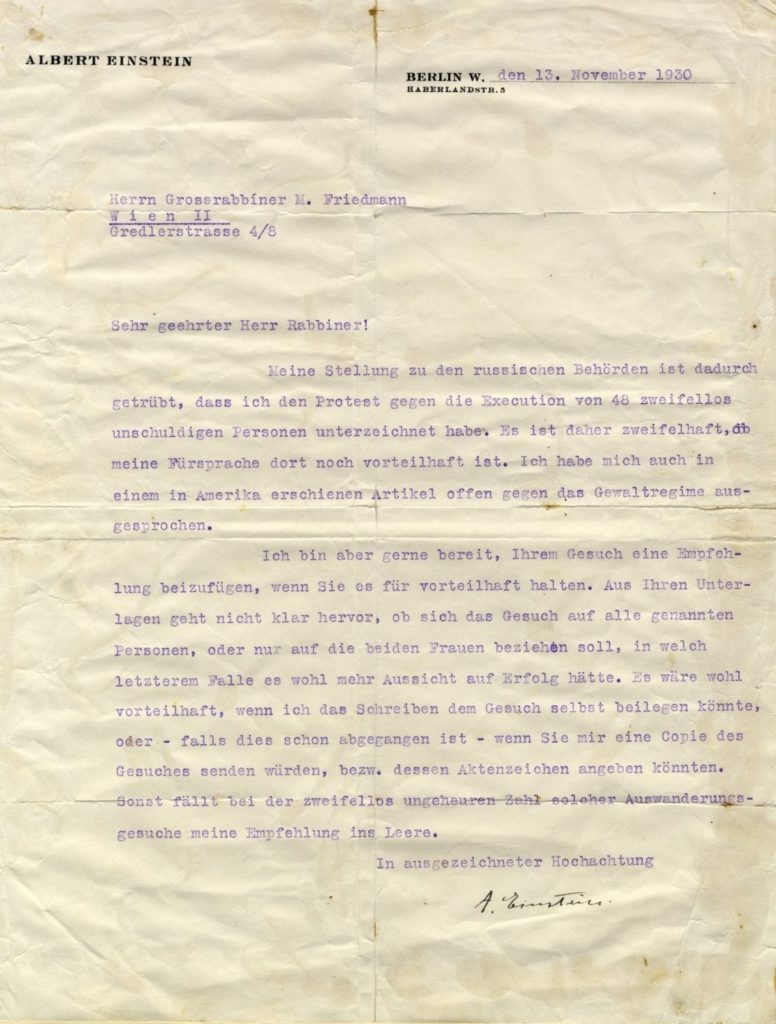
Letter by Albert Einstein to the Admor of Sadigura, Mordechai Sholom Yosef Friedman, then residing in Vienna, Austria, dated November 1930. Einstein replies to a request by the rabbi to save two female members of his family from persecution in the Soviet Union. Berlin, 13.11.1930.
Specifications: [1] leaf, letterhead. 28×22 cm. German. Typewritten and signed by Einstein.
Unique Features: The Admor asked Einstein to help him rescue two female relatives from a death sentence in Soviet Russia. In this letter of response, Einstein expresses his willingness to help, but is unsure if his involvement will be beneficial. His relationship with the Soviet government had been recently undermined, when he signed an open protest opposing the execution of 48 innocent people. Not only that, but also an article expressing his opposition to the tyrannical government had been published in the United States.
This is an example of Einstein’s unlimited willingness to help fellow Jews and also a rare example of correspondence with a senior rabbinic figure.
Condition: Fine. Fold marks with a few small tears along the fold line, light marginal blemishes, signs of dampness, aging stains.
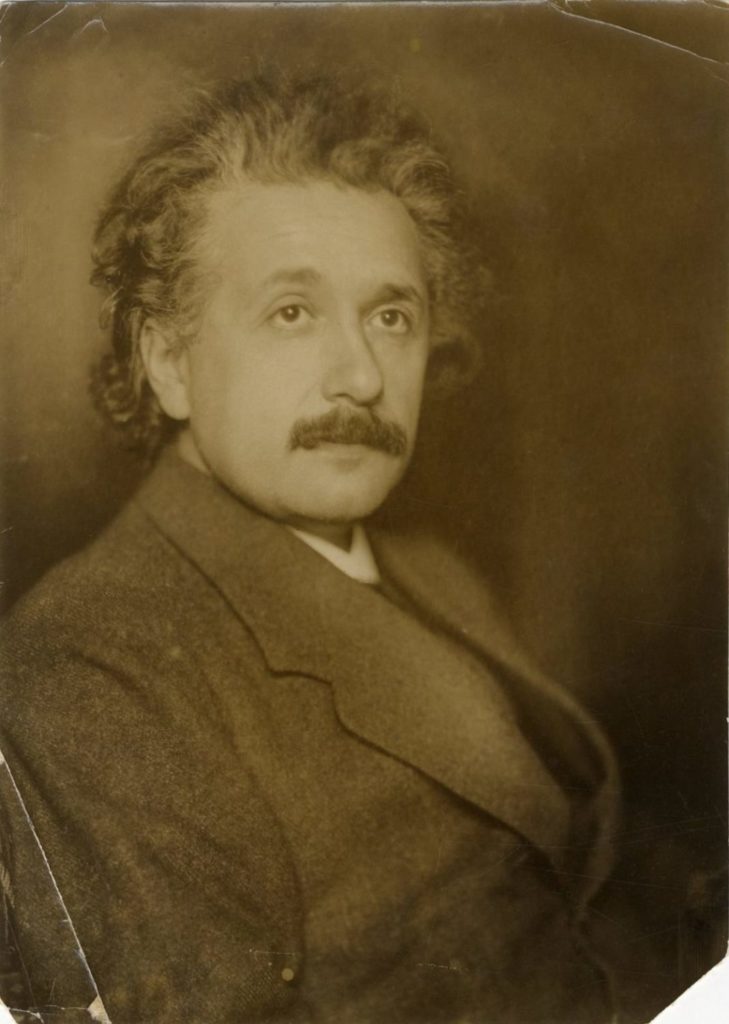
Original b lack and white photograph of the renowned scientist Prof. Albert Einstein, c. 1922 – the year it was decided to award him the Nobel Prize.
Specifications: [1] original photograph, 11.9 x 16.6 cm. Photographer’s stamp and handwriting on the photo’s back.
Condition: Fine-very fine. Cut in the lower right corner. Creases in the corners.

Collection of approximately [10] original press photographs taken of Albert Einstein between 1929-1934 in Germany, England and the United States.
1. Photograph of Albert Einstein on his 50th birthday, with his wife Elsa and his daughter Margot. Berlin, March 14, 1929
2. Einstein and Lord Robert Cecil in the Reichstag building, Berlin. 6.4.1929. Lord Robert Cecil was a British lawyer, politician and diplomat who won the Nobel Peace Prize in 1937.
3. Einstein standing on a boat – a gift for his 50th birthday. The Wannsee River, Berlin, 10.06.1929. [Einstein was born on 3.14.1879.]
4. Einstein on his boat, received as a gift for his 50th birthday, on the Wannsee River, Berlin. Beside him is the engineer, Harms. 06.10.1929.
5. Albert Einstein on his arrival in London to participate in a dinner at the Savoy Hotel, held on behalf of the British Joint Distribution Committee of the organizations ORT and Oz, to promote the economy and well-being of the Jews of Eastern Europe. 10.28.1930.
6. 6. 66n66Albert Einstein with his daughter Margot and her husband Dimitri Marianoff on their wedding day. Berlin, 11.29.1930
7. Prof. Einstein leaving Germany forever. December, 1932.
8. Albert Einstein and his wife at a conference of Nobel Prize winners to commemorate the centenary of Alfred Nobel’s birth. Roosevelt Hotel, 12.18.1933.
9. Prof. Einstein shaking hands with Governor A. Harry Moore during a meeting with the House of Representatives of the State of New Jersey. Trenton, New Jersey, 4.10.1934.
10. Einstein informally discussing his theories after giving a lecture at the American Organization for the Advancement of Science conference, 12.28.1934. The conference was held at the University of Pittsburgh, Pennsylvania, USA, 12.27.1934 – 1.2.1935.
Condition: Overall fine to very fine.
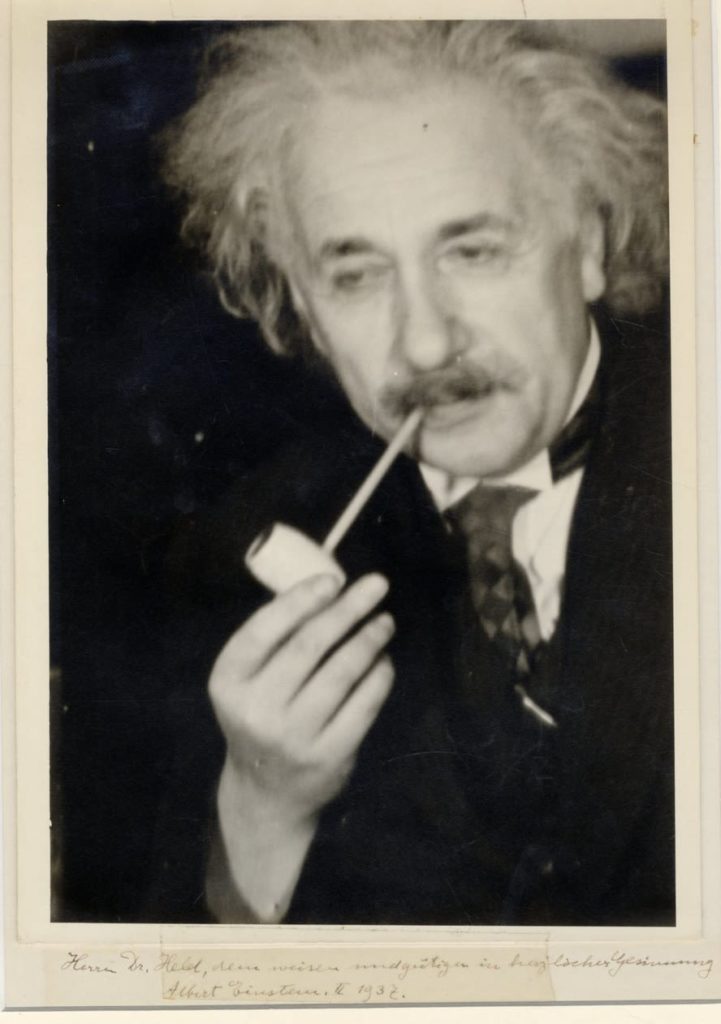
Large and interesting artistic photograph of Prof. Albert Einstein smoking a corn pipe, presented to his good friend Dr. Held . 1937
Specifications: [1] original photograph. 18X25 cm. The photograph was originally pasted onto a cardboard, which was later reinforced from behind with transparent adhesive tape on the top and bottom.
Unique features: There is apparently no known copy of this delightful and unique photograph. Photographs that document Einstein smoking a corn pipe are rare. The photographer created an artistic element to the photograph using a technique called “soft focus.” On the lower part of the cardboard, under the photograph, Einstein wrote: “To the wise and good Mr. Dr. Held, with affection, Albert Einstein, February 1937.”
Condition: Very fine, with the exception of tears at the edges of the cardboard on which the photograph was affixed, without damage to the photograph or inscription.
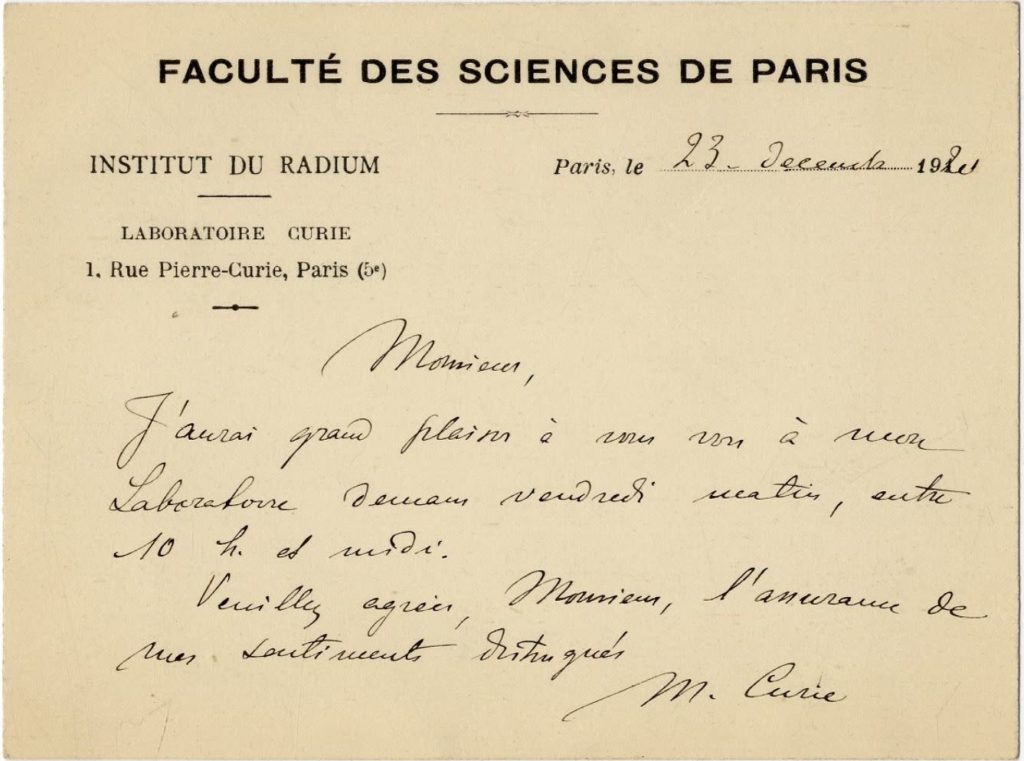
Official postcard from Pierre Curie Laboratories of the Radom Institute in Paris, autographed by Prof. Marie Curie, 1921.
Specifications: [1] Curie Laboratories of the Radom Institute in Paris official postcard. 13×10 cm. Handwritten and signed by Prof. Curie.
Background: Marie Curie [1867-1934] was a breakthrough scientist and pioneer in the field of radioactivity research. She studied chemistry and physics at the Sorbonne in Paris and was the first woman student to receive a bachelor’s degree in physics, the first woman in France to receive a doctorate. In 1906, she was also the first woman to serve as a lecturer at the Sorbonne. In 1903 she and her husband Pierre won the Nobel Prize in Physics for radiation research, and in 1911 won the Nobel Prize in Chemistry for the discovery of polonium and radium; making her the first woman to win the Nobel Prize, and the first person to win it twice. Her death was caused by an illness that developed as a result of her exposure to radioactivity during her research. A year later, her daughter also won the Nobel Prize in Chemistry. Marie Curie’s life work is documented in many museums, books and films, and her image continues to inspire many researchers. Her name was immortalized in the scientific world by the chemical element named after her, “curium,” the unit of radioactivity, the “curie,” research institutes, scholarship funds, and scientific prizes. Dozens of years after her death, her bones and her husband’s bones were transferred to the Pantheon in Paris, where the most important personalities of the French nation are buried.
Condition: Very fine.
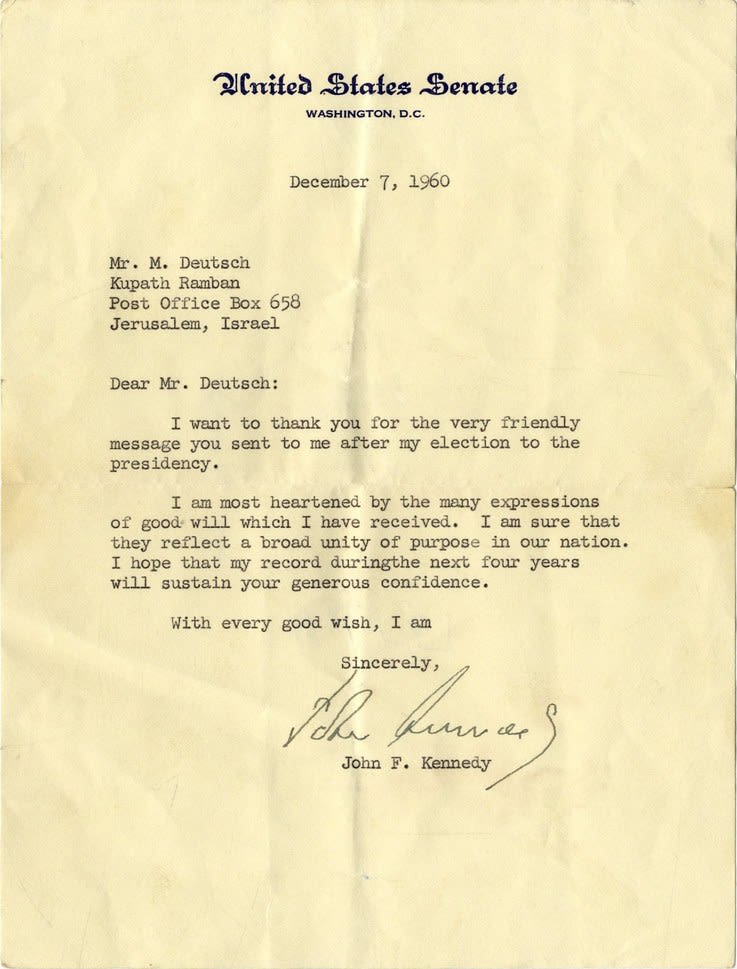
Thank you letter from Senator John F. Kennedy after being elected president of the United States, sent to Mr. M. Deutsch of the Kupat Rabbi Meir Baal HaNes charity in Jerusalem. Washington D.C. 7.12.1960.
Specifications: [1] official U. S. Senate letterhead. 21×15 cm. Typewritten with Kennedy’s signature. With original, official Senate envelope. 11×16 cm.
Background: The letter was written about a month after the presidential elections, but before he was sworn in. “I am most heartened by the many expressions of good will which I have received. I am sure that they reflect a broad unity of purpose in our nation. I hope that my record during next four years will sustain your generous confidence.”
Kennedy was murdered on 22.11.1963 and did not complete his presidency.
Condition: Fine. Fold marks with light creases on the leaf, small tear along the fold line, not affecting text. Stains on the envelope.